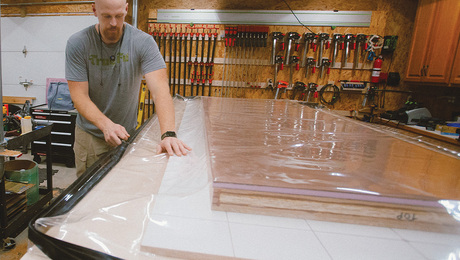I was watching an old episode of ‘I Want That’ on DIY and they touched on concrete logs for a faux-log home. The one company they briefly mentioned was Cultured Log Systems http://www.concretelogs.com/ but I had not heard of anyone mentioning them before.
Has anyone any experience with this approach to construction? What might be the good, bad, and ugly they are not mentioning (aisde from price)? Here is a pciture:
http://www.concretelogs.com/images/SeeleyLake/seeley1.jpg
Edited 7/2/2007 5:41 am ET by Nuke




















Replies
All the PITA aspects of working up to logs (straight lines meeting round surfaces) but without the workability of wood. Sounds like a nightmare to me.
No but I have done Concrete fence before. There is a better tolerance for error on that so I cant imagine building log house from those.
Very cool. I hadn't heard of them before but it makes sense that lightweight concrete building products will be more and more prevelent.
Out west some clients are simply sold on the log look and we've done some hand pealed log siding that gives the benefits of a stick built house and the exterior look of log, but then there's still a couple grand in maintence every couple of years. In 50 years a concrete product looks pretty cheap compared to top quality logs with good upkeep.
Beer was created so carpenters wouldn't rule the world.
Seems like a good system. It appears to be well engineered, and thought out.
They shouldn't have all the typical log construction issues, precast concrete is typically very dimensionally true. Construction tolerances for the footings, would probably be critical. And, since it doesn't seem like it would be easily modified in the field, you would want to have a well thought out plan before you started. Mid process changes would seem to be difficult.
That said, they do the erection, so if you get the foundation and embeds right, it should go up pretty quickly, and the interior would probably be far easier to finish than a typically log home. Having walls that are true, plumb, and basically flat should be a big help.
I always thought the reason log houses were built was that in the absence of milling tools, and in an environment where settlers had an abundance of logs from clearing land, they were all they could manage. A primitive, inefficient method of building that people abandoned as soon as a more sophisticated alternative was available.
The only virtue they have today is their unique heavy wood feel. Take the wood away and I can't imagine why anyone would want to build one.
unique heavy wood feel
Well, there's actually a great deal of thermal mass in a log home--which is why they were built in Sweden until fairly recently. They also have a lot of resistances--fire, rot, insects, etc. by dint of that very self-same mass.
That being said, it would be hard to imagine a worse structure for the utilities of a modern house--which is why almost every moderincarnation of "log home" has flaws and imperfections that potetentailly compromise the house in very really and very immediate sorts of ways.Occupational hazard of my occupation not being around (sorry Bubba)
I'm not sure how much thermal mass benefits a structure when it has very little insulating value or is not protected by insulation. CMHC did a lot of tests on log homes as there was some debate over whether they met codes for insulation. The log builders association claimed somewhere around an R 15. The best CMHC could get was R 6. Believe it or not the association responded with "Well they feel warm"
Most of the log houses I've dealt with had air infiltration problems and the butt ends were subject to rot and rife with insect infestations. They have a wonderful feel to be in, and maybe that's reason enough to build one. I just think that compared to other more contemporary methods of building they don't stand up.
Ah, definition problems.
Not the modern "log home" at all. The swedish houses are oocaionally called "three log houses"--so the walls are in the range of 2-3' thick. The old-fashioned log house, with timbers at lease 12" around, and chinked to about a 10" of average wall thickness have decent R values; their lack of windows & doors adding to that.
The modern creations, with a 6x8 milled witha semi-round two sides and only a polyvinyl spline--that's not a log house; it's a weird way of making a dry-stack house is all.Occupational hazard of my occupation not being around (sorry Bubba)
I am not sure why you would apply anything relating to conventional wood logs to this product. Just because its of the appearance of a log, its concrete. Should one be concerned with insect infestation and rot on this? I seriously doubt it, but I'm open to any enlightenment.
And as a faux log appearing concrete look what exactly makes it bad compared to every other concrete-based shell construction method? I find it strange anyone would apply real-product experiences to another that only mimicks in appearance.
I also do not see where the difficultings may come in for mechanicals. Other forms of construction have been praised, but even their ability to adapt mechanicals come with great effort and accommodation.
Also, many people buy into a new log home because they want the old time rustic appearance while being accommodated the modern interior appearances and technologies that have since been developed. I do not know anyone that wants a log home based only on 18th century technology.
I tried to find some interior shots to get an idea of how they are being fitted out:
http://www.concretelogs.com/images/Potomac/Potomac6.jpg
http://www.concretelogs.com/log34_large.jpg
Also noticed this: http://www.concretelogs.com/images/technical_drawing.gif
I would be curious to know the adapted system for mechnicals and general high/low voltage wiring.
I related my experiences about conventional log construction in response to CapnMac's comments. I am sure that the concrete version is a response to these shortcomings and no doubt does a good job in addressing them. For me it still comes down to eliminating the one reason to build that way: the wood.
I do use other cement based wood replacement products like Hardiplank. But I always find myself asking "Is there enough real wood around it to make it look good?" I use it for practical reasons, but I don't try and fool myself it looks as good as cedar. I didn't mean to be overly negative about these, I just can't see the appeal.
Also, many people buy into a new log home because they want the old time rustic appearance while being accommodated the modern interior appearances and technologies that have since been developed. I do not know anyone that wants a log home based only on 18th century technology.
Well, that's the "thing" I've run into with people wanting me to help them with a "log home." They want the rustic appearance of chinked logs on the inside while also having smooth walls for the tile in the kitchen, the convenience of wall board for hanging pictures or running speaker wires. In short, they want to eat the cake, and have it too.
Sadly, I now have a habit, I flat turn down anyone who wants their plan-book plans redrawn for "log construction." Upsets folks to get turned down that way, but better up front than after $2k of fees.
From that detail, though--the faux logs might be interesting. May have to look to see what the corner details are like. Might make for some cool "outdoor" structures that would also be low-maintenance.Occupational hazard of my occupation not being around (sorry Bubba)
In earlier times, log homes were just a step up from the sod houses on the prairie.
I've done quite a bit of log work, including in my own crib, but I always found it interesting how, when early settlers got settled in and established, many of them "upgraded" their log homes by covering the logs with a variety of different things to disguise the fact they, indeed, were living in a log home.
Some of the restoration entrepreneurs ferreted out alot of of those old hewn log houses in Canada and the US, tore them down and reasembled them for well-to-do clients who were seeking the rustic charm.
But I'm sure some of those original owners would be aghast at the effort made to remove the asphaltic roll-on fake brick siding they'd worked so hard to apply, just so someone could make their old log house look like a log house again.
Nuke,
The most most unfortuneate apsectes of home building are when somebody comes out with a cheap or replacement for the original.
Log homes have their shortcomings, cement may improve that somewhat but without any of the benefits of real logs.
they touched on concrete logs for a faux-log home.
Me, I prefer the real wood logs made to look like concrete.
Man, my 150+ Year old White oak logs are like concrete. Impossible to drive a nail or screw into, will dull a sawblade in a second.
I don't think I've ever came across any wood as hard as some of this, almost petrified.
You do learn to do things a lot differently...LOL
My floor trees...I mean joists are made of oak as is the rest of my framing beams and studs...you wanna talk hard!! The house is 326 years old so these trees are probably over 400 years old...gettin' a nail in em? Ha..Petrified?Nope....nails are skeered to death...lol.
"Even if embryonic stem cells are absolutely good for nothing at all how can anyone in good conscience be against using them for research given that they are going to be destroyed anyway"? J.Hayes
http://www.john-lennon.com/imagine-neilyoung.ra
http://WWW.CLIFFORDRENOVATIONS.COM
Well I'll be danged -- what'll they think up next? I've never been fond of superficially emulating one material with another, and stopped being a fan of log houses when I was about 10. But I've built dozens over the years -- everything from fell the trees & hew the logs to milled kits. When someone asks for my advice on building a log home, I run through the technical pros and mostly cons, and then tell them that it's sorta' like riding a Harley -- no way to justify it technically -- just a matter of how it makes you feel.
Since any log home is more a right brain than left brain thing anyway, heck -- why not try something different that could help with some of the more egregious issues?
}}}}
For what it's worth....
The exterior of the Sun Valley Lodge (built in 1936) is all concrete. They built the forms of rough-sawn lumber and then stained the concrete. You have to be pretty close (touching distance) to tell that it's not wood.
Last time I was there was in 1996. Sixty years old and it looked great--both inside and out.
Kathleen